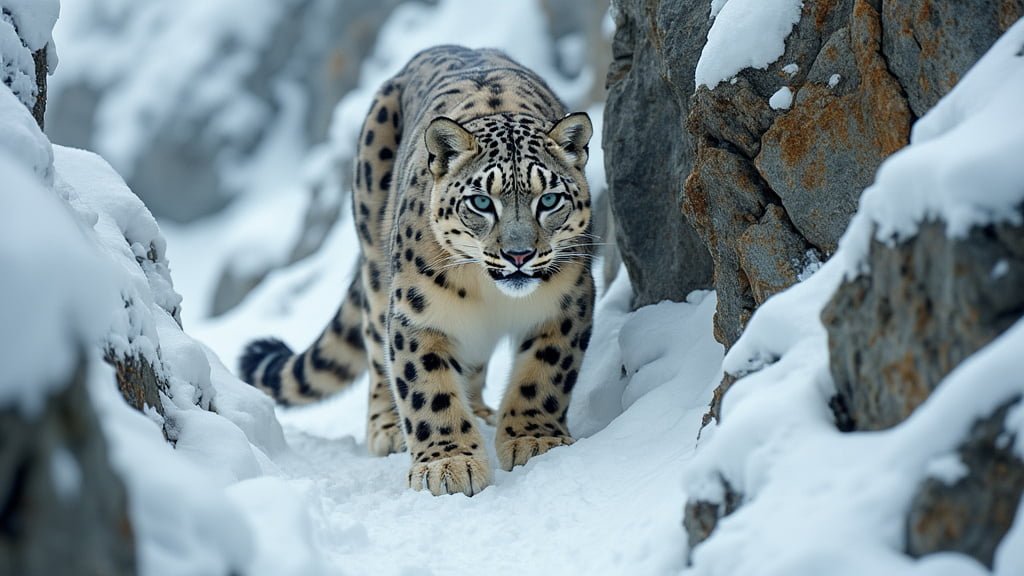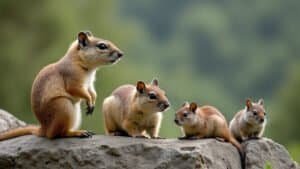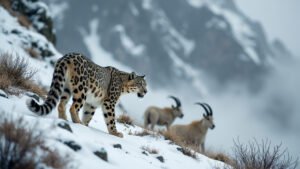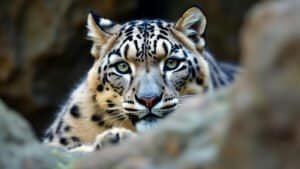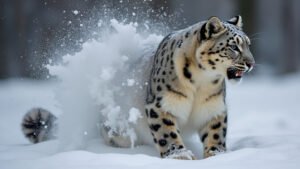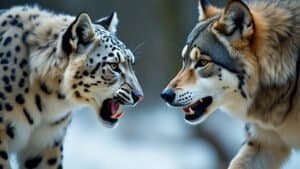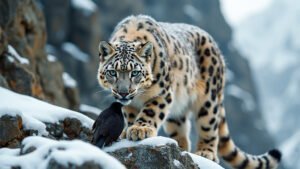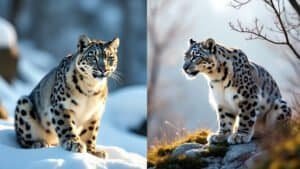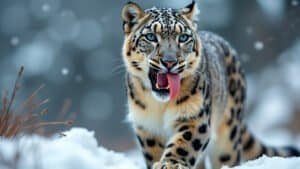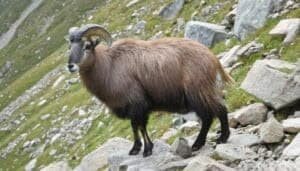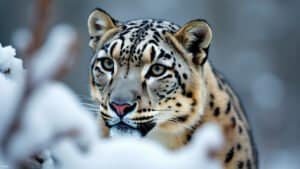Introduction
Snow leopards are apex predators adapted to survive in the harsh, mountainous regions of Central and South Asia. Their feeding habits are crucial for maintaining the energy needed to thrive in these environments
This article delves into the intricate relationship between what snow leopards eat, how often they hunt, and the energy they expend in the process. We will explore their diet, the challenges posed by prey scarcity, and how environmental factors like terrain and climate impact their energy balance
The article also examines the physiological effects of irregular feeding and compares snow leopards’ energy use to that of other big cats in similar habitats
Snow Leopards’ Diet and Energy Needs
Snow leopards (Panthera uncia) are solitary predators that inhabit the remote, high-altitude regions of the Himalayas, Central Asia, and southern Siberia
The scarcity of prey in these rugged terrains demands that snow leopards maintain a finely-tuned energy balance to survive. Their diet is primarily composed of medium to large ungulates, but it can vary significantly depending on availability, season, and specific regional ecosystems
Typical Prey and Caloric Value
In the wild, snow leopards mainly hunt blue sheep (bharal), Argali sheep, ibex, and other mountain ungulates. These animals are their primary food source, providing the high caloric intake necessary for survival in the cold, harsh climates of the mountains
According to studies, a single adult blue sheep, weighing around 77-165 pounds, can provide a snow leopard with up to 35,000 calories. This is sufficient to sustain the leopard for up to a week or more, depending on its energy expenditure, though the actual number of feeding days depends on various factors such as the availability of prey and the energy expended in capturing it
Smaller prey, such as marmots, hares, and birds, also form part of their diet, especially when larger prey is scarce. However, these smaller animals provide significantly fewer calories
For example, a marmot, weighing about 10-15 pounds, might only offer about 3,000-4,500 calories, which is far less energy-efficient for the leopard, considering the effort required to catch it
Impact of Seasonal Diet Variations
The availability of prey is highly seasonal in the snow leopard’s habitat. During the warmer months, when ungulates migrate to higher altitudes, snow leopards often follow, relying on their agility and camouflage to hunt
In winter, when prey animals descend to lower altitudes or huddle in smaller, more difficult-to-access areas, snow leopards must travel greater distances or shift to hunting smaller, less calorie-dense animals
This seasonal shift in diet can have profound effects on the snow leopard’s energy budget. During leaner months, when prey is scarce or less nutritious, snow leopards may struggle to meet their energy needs, leading to weight loss and decreased reproductive success
A study published in Biological Conservation highlighted that during winter, snow leopards’ diets might shift towards smaller mammals, which requires them to hunt more frequently, thereby increasing their overall energy expenditure
Role of Metabolism in Energy Conservation
Snow leopards have adapted to their environment by developing a metabolism that conserves energy during times of scarcity. Their thick fur and large paws, which act like snowshoes, allow them to move efficiently through deep snow, reducing the energy cost of movement
Additionally, their ability to consume large quantities of food in one sitting—up to 20% of their body weight—allows them to store fat and sustain themselves over periods when food is scarce
Metabolic adaptations also include a slower digestion process, which maximizes the absorption of nutrients from their meals. This slow metabolism is a double-edged sword, however, as it means that snow leopards must balance the need to conserve energy with the need to obtain enough food to fuel their basic physiological functions and hunting activities
Snow leopards must be strategic in their hunting, often relying on surprise attacks from elevated positions to minimize the energy expended during a hunt. By carefully selecting their prey and conserving energy through efficient hunting techniques and metabolic adaptations, snow leopards manage to survive in one of the most challenging environments on Earth
Hunting Behavior and Energy Expenditure
Snow leopards are stealthy and powerful hunters, perfectly adapted to their mountainous habitat. The hunting behavior of snow leopards is a key determinant of their energy expenditure
Their survival depends on a delicate balance between the energy they expend in hunting and the energy they gain from consuming prey
Understanding the specific techniques they use and the challenges posed by their environment reveals how these majestic cats manage to maintain this balance in a habitat that often seems inhospitable
Stalking and Ambush Techniques
Snow leopards are masters of stealth. Their pale, spotted fur provides excellent camouflage against the rocky, snowy landscapes of their habitat, allowing them to approach prey undetected
Snow leopards primarily rely on ambush techniques, which involve patiently stalking their prey and getting as close as possible before launching a surprise attack. This approach minimizes the distance they must cover at high speed, conserving energy
According to a study by the Snow Leopard Trust, snow leopards often position themselves above their prey, using the terrain to their advantage by attacking from above, where they can use gravity to their benefit during the chase
The stalking phase, though crucial, requires patience and precision. The leopard must move slowly and deliberately to avoid detection, often taking hours to close the distance to its target
This slow, careful movement is energy-efficient compared to a full sprint, but it does require significant focus and persistence. If the ambush fails, the snow leopard may have to abandon the hunt to conserve energy, as repeated failures can lead to significant energy deficits
Energy Costs of Hunting in Rugged Terrain
The rugged terrain of the snow leopard’s habitat presents significant challenges during hunting. Steep slopes, deep snow, and rocky outcrops all increase the physical demands of a chase
Research published in The Journal of Experimental Biology highlights that moving through snow-covered terrain can increase energy expenditure by up to 50% compared to moving on flat, snow-free ground. The thick fur and muscular build of snow leopards help mitigate some of these costs, but the effort required to traverse these environments is still considerable
Chases are usually short and intense, lasting only a few seconds to a minute, as snow leopards rely on explosive bursts of speed and strength to overpower their prey
However, the steep and uneven terrain can cause a high rate of failed hunts. A study on big cat hunting success rates indicates that snow leopards may only succeed in 20% of their hunting attempts, which means that a significant amount of energy can be expended without any caloric return
When a hunt is successful, the energy reward can be substantial, particularly if the prey is large. However, the energy cost of a failed hunt can be detrimental, especially if the snow leopard is already in a caloric deficit due to previous unsuccessful attempts or the scarcity of prey
Adaptations for Efficient Hunting
Over time, snow leopards have developed several adaptations that help them hunt more efficiently in their challenging environment
Their powerful hind limbs allow them to leap up to 50 feet horizontally, which is an essential adaptation for covering ground quickly during a chase or moving across difficult terrain. Their long, thick tails provide balance and stability on steep, rocky surfaces, reducing the risk of falls that could result in injury and further energy loss
Snow leopards also have large nasal cavities, which warm the cold air they breathe and help them maintain their body temperature during physical exertion at high altitudes. This adaptation is particularly important during hunts, where the combination of physical exertion and cold temperatures could otherwise lead to rapid energy depletion
Another crucial adaptation is their ability to fast for extended periods between hunts. In the wild, snow leopards may go several days or even weeks without a successful hunt, particularly in winter when prey is scarce. Their ability to enter a state of low metabolic activity allows them to survive these periods of scarcity without expending significant energy
However, prolonged periods without food can lead to muscle loss and a decrease in overall health, making subsequent hunts more difficult and further increasing the energy expenditure required to capture prey
Impact of Environmental Factors on Feeding
The harsh and variable environment in which snow leopards live plays a significant role in shaping their feeding habits and energy expenditure. The extreme altitude, challenging terrain, and seasonal climate changes create a landscape where energy balance is critical for survival
Understanding how these environmental factors affect snow leopards’ feeding behaviors and energy dynamics is essential to appreciate their resilience and adaptability
Effects of Terrain and Altitude
Snow leopards inhabit some of the most rugged and inaccessible terrains on Earth, ranging from 9,800 to 16,400 feet above sea level
This high-altitude environment is characterized by steep slopes, rocky outcrops, and deep snow, all of which increase the physical demands on the snow leopards as they hunt and move through their territory
The energy required to navigate this terrain is substantial, with studies indicating that animals at higher altitudes expend more energy just to maintain their basic physiological functions due to lower oxygen levels and colder temperatures
The energy costs associated with altitude are exacerbated by the fact that prey animals, such as ibex and blue sheep, are often found in similarly challenging locations. Snow leopards must be capable of pursuing these animals across difficult terrain, which not only requires significant physical exertion but also increases the risk of injury
The uneven and unpredictable landscape means that even small missteps can lead to falls or other injuries that could hinder a snow leopard’s ability to hunt effectively, leading to increased energy expenditure for subsequent hunts
Moreover, the fragmented and expansive nature of their habitat means that snow leopards often have to travel long distances to find suitable prey. This increases their daily energy expenditure, making each successful hunt crucial to maintaining their energy balance
Seasonal and Climatic Influences
Seasonal changes significantly impact the availability of prey and, consequently, the feeding habits of snow leopards. During the warmer months, when prey animals are more abundant and active, snow leopards may have more frequent hunting opportunities, allowing them to maintain a positive energy balance
However, in winter, prey becomes scarcer and more difficult to catch. Ungulates, which make up a large portion of the snow leopard’s diet, often move to lower altitudes or become less active to conserve energy, making them harder to locate and capture
Winter conditions also present direct challenges to snow leopards, as they must deal with deep snow, icy surfaces, and extremely low temperatures. These conditions not only make hunting more difficult but also increase the energy required for basic survival
A study published in Global Ecology and Conservation found that snow leopards expend up to 50% more energy during the winter months due to the increased difficulty of hunting and the need to maintain body heat in freezing conditions
Additionally, climate change is starting to alter the habitats of snow leopards, potentially reducing the availability of prey and increasing the frequency of harsh weather events
These changes could force snow leopards to expand their ranges, increasing their energy expenditure further. As their prey migrates to higher altitudes or new areas in response to warming temperatures, snow leopards may be forced to adapt their hunting strategies, further complicating their energy balance
Comparison with Other Big Cats
Snow leopards face unique environmental challenges that set them apart from other big cats, such as tigers or lions, who generally inhabit lower altitudes and more temperate regions. For example, tigers in the Siberian taiga also face harsh winters but benefit from a more stable prey base and less extreme terrain
Similarly, lions in the African savannah face high temperatures and the challenges of dry seasons but do not have to contend with the steep slopes or high altitudes that characterize snow leopard habitats
Despite these differences, a comparison of energy expenditure between these species reveals that snow leopards have adapted exceptionally well to their environment
For instance, while lions may expend significant energy in prolonged chases across the savannah, snow leopards have evolved to maximize their energy efficiency by minimizing the distance and duration of their hunts. This contrast highlights the unique adaptations snow leopards have developed to survive in their specific ecological niche
In conclusion, the environment plays a critical role in shaping the feeding habits and energy dynamics of snow leopards
The challenges of high altitude, rugged terrain, and seasonal variability require snow leopards to be highly efficient in their energy use, making every hunt and every calorie crucial for their survival. Understanding these factors is key to conserving these magnificent predators as their habitat continues to change
Physiological Impacts of Irregular Feeding
Snow leopards, like many apex predators, often face periods of food scarcity that can lead to irregular feeding patterns
These irregularities in their diet can have profound physiological impacts, affecting everything from their muscle mass and fat reserves to their reproductive health and overall survival strategies. Understanding these impacts is crucial to grasp how snow leopards cope with the challenges of their harsh environment
Effects on Muscle Mass and Fat Reserves
One of the most immediate physiological impacts of irregular feeding in snow leopards is the loss of muscle mass and depletion of fat reserves. In periods when food is scarce, snow leopards rely heavily on their stored fat to provide energy
However, once these fat reserves are depleted, the body begins to metabolize muscle tissue to meet energy demands. This can lead to a significant loss of muscle mass, which in turn reduces the leopard’s strength and hunting efficiency
A study published in Journal of Mammalogy found that prolonged periods of fasting can lead to a reduction in lean body mass by as much as 25%
For snow leopards, this loss of muscle can be particularly detrimental, as it affects their ability to traverse their rugged habitat and successfully hunt prey. Furthermore, muscle loss can also impair thermoregulation, making it harder for snow leopards to maintain their body temperature in the cold environments they inhabit
Replenishing these fat and muscle stores requires regular, successful hunts, which can be challenging in the snow leopard’s environment
The cyclical nature of fasting and refeeding can create a difficult balance, where snow leopards must optimize their energy use and hunting strategies to recover from periods of scarcity
Impact on Reproductive Health
Irregular feeding can also have significant implications for the reproductive health of snow leopards. Adequate nutrition is essential for both male and female snow leopards during the breeding season
For females, in particular, sufficient fat reserves are crucial for supporting pregnancy and lactation. If a female snow leopard experiences food scarcity during pregnancy or while nursing cubs, it can lead to lower birth weights, reduced milk production, and higher cub mortality rates
Research indicates that female snow leopards require higher caloric intake during gestation and lactation to ensure the healthy development of their offspring. A lack of consistent food sources can lead to reproductive failures, with some studies suggesting that snow leopards may forgo breeding altogether during years of extreme food scarcity
This reproductive strategy, while conserving the female’s energy, can have long-term effects on snow leopard populations, particularly in areas where prey is consistently scarce
In males, irregular feeding and the resulting nutritional deficits can lead to reduced sperm quality and decreased overall fertility. The stress associated with food scarcity can also suppress reproductive hormones, further impacting their ability to successfully mate and produce offspring
This physiological stress can have cascading effects on population dynamics, especially in fragmented habitats where finding a mate is already challenging
Long-Term Survival Strategies
To cope with the unpredictable availability of food, snow leopards have developed several long-term survival strategies. One such strategy is reducing their overall activity levels during periods of food scarcity to conserve energy
By limiting their movement and focusing on resting, snow leopards can reduce their metabolic rate and extend the time they can survive without a substantial meal. This energy conservation strategy is similar to that observed in other large carnivores, such as polar bears, which also experience extended periods of fasting
Additionally, snow leopards may expand their home ranges in search of food during times of scarcity. This territorial flexibility allows them to exploit new prey populations and habitats, though it comes with increased energy costs associated with longer travel distances
Expanding their range also increases the likelihood of encountering other predators or human activity, which can introduce new risks and challenges
Another survival strategy involves the timing of hunts. Snow leopards may adjust their hunting patterns based on the behavior of their prey, targeting animals that are less vigilant or more vulnerable due to environmental conditions
This adaptive behavior helps snow leopards maximize the efficiency of each hunt, reducing the overall energy expenditure required to capture prey
Conclusion
The feeding habits of snow leopards are intricately linked to their energy expenditure, a balance that is critical for survival in the harsh, mountainous environments they inhabit
Their diet, primarily consisting of large ungulates, provides the necessary caloric intake to sustain their energy needs, but the availability of this prey is highly variable, influenced by both seasonal changes and the challenging terrain
Snow leopards have developed specialized hunting behaviors, such as ambush techniques and energy-efficient movement through rugged landscapes, to optimize their energy use during hunts
Environmental factors, including altitude, terrain, and seasonal climate variations, further complicate their energy dynamics, often leading to periods of food scarcity that can have profound physiological impacts. These include the depletion of muscle mass and fat reserves, as well as potential reproductive challenges
Despite these difficulties, snow leopards have evolved a range of survival strategies, from reducing their activity levels to expanding their home ranges in search of food, showcasing their remarkable adaptability
Overall, understanding the relationship between feeding habits and energy expenditure in snow leopards is essential for conservation efforts, as it underscores the importance of preserving their prey base and natural habitat to ensure the survival of this majestic and endangered species
